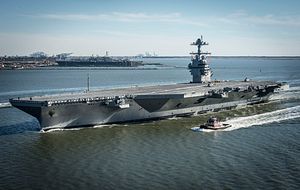The U.S. Navy’s long-delayed nuclear-powered Gerald R. Ford-class aircraft carrier USS Gerald R. Ford (CVN-78), the lead ship of the service’s class of next-generation carriers, will be commissioned at Naval Station Norfolk, Virginia on July 22. The ship was originally slated to be commissioned in the summer of 2016.
Once commissioned, it will be the U.S. Navy’s most expensive warship of all time, with total costs for the USS Gerald Ford estimated at almost $13 billion, including $2.3 billion in cost overruns due to the ship’s many new and unproven systems. The new carrier features a host of new and untested technology, including the ship’s two main turbine generators, a new dual-band radar system, advanced weapons elevators, and a new advanced arresting gear on the flight deck. U.S. President Donald Trump objected to the installation of some of the new systems such as General Dynamics’ new electromagnetic aircraft launch system (EMALS) aboard the USS Gerald R. Ford, as I reported in May.
The USS Gerald Ford successfully completed acceptance trials on May 26 conducted by the U.S. Navy’s Board of Inspection and Survey, and builder’s sea trials in April overseen by Huntington Ingalls Industries-Newport News Shipbuilding and the Navy’s CVN 78 Program Office.
According to the U.S. Navy, “the next generation of aircraft carrier, the Gerald R. Ford class delivers unprecedented flexibility to the fleet. Due to a larger flight deck, the ability to host more aircraft, additional weapons and aviation fuel storage, and the Electromagnetic Aircraft Launch System and Advanced Arresting Gear, Ford will be able to increase sortie rates by one-third when compared to the Nimitz class.”
In addition, “the Navy’s newest aircraft carrier generates three times the amount of electricity as previous classes and is designed to rapidly add capabilities as new systems become available over the course of its projected 50-year service life.” The ship is scheduled for its first deployment in 2022. However, this date could be moved up to 2019 or 2020, given that the U.S. Congress is considering striking the requirement for the ship to undergo shock trials in order to expedite the USS Gerald Ford’s first deployment, Defense News reports.
“The Navy initially didn’t want to shock-trial [Ford], they wanted to shock-trial [John F. Kennedy],” a congressional aide to the House Armed Services Committee’s Seapower (HASC) and Projection Forces Subcommittee told Defense News. “So … by taking out the shock trial associated with CVN-78, we are at least able to accelerate the Ford delivery by at least a year.” The HASC intends to insert language in its markup of the 2018 National Defense Authorization Act that would strike the requirement to send USS Gerald Ford into shock trials, although the U.S. Navy could still choose to do so.
































